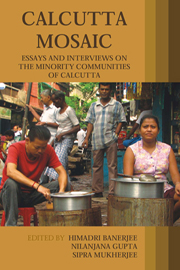Book contents
- Frontmatter
- Contents
- List of Contributors
- Acknowledgements
- Introduction
- 1 Mapping the Spaces of Minorities
- 2 The Armenians of Calcutta
- 3 The Jews of Calcutta: An Interview with Michael Ezra
- 4 The Sindhis of Calcutta
- 5 The City of Colleges
- 6 The Chinese Community of Calcutta
- 7 The Anglo–Indians of Calcutta
- 8 The Biharis of Calcutta
- 9 Agraharis of Calcutta
- 10 A Journey into My Neighbourhood
- 11 The ‘South Indians’ of Calcutta: Experiences in Cultural Processes
- 12 ‘Non-Bengali’ Icons of Malevolence
- 13 Selfing the City
3 - The Jews of Calcutta: An Interview with Michael Ezra
Published online by Cambridge University Press: 05 March 2012
- Frontmatter
- Contents
- List of Contributors
- Acknowledgements
- Introduction
- 1 Mapping the Spaces of Minorities
- 2 The Armenians of Calcutta
- 3 The Jews of Calcutta: An Interview with Michael Ezra
- 4 The Sindhis of Calcutta
- 5 The City of Colleges
- 6 The Chinese Community of Calcutta
- 7 The Anglo–Indians of Calcutta
- 8 The Biharis of Calcutta
- 9 Agraharis of Calcutta
- 10 A Journey into My Neighbourhood
- 11 The ‘South Indians’ of Calcutta: Experiences in Cultural Processes
- 12 ‘Non-Bengali’ Icons of Malevolence
- 13 Selfing the City
Summary
One of the first Jews to arrive in Calcutta towards the end of the eighteenth century was Shalom Aharon Ovadiah HaCohen. He was an ambitious young merchant from Alleppo who came to Calcutta via Surat. Interested in establishing trading links from London to Shanghai, Shalom and the other early Jewish settlers traded in indigo, ivory, cotton, yarn, gold leaf, silk, Veniceware, precious stones, coffee, and cash crops like sesame oil, jute, sugar, spices, indigo and later, opium. Shalom was soon joined by his nephew Moses Simon Duek HaCohen, who played a key role in framing the first constitution of the community. Around this time also arrived, for a brief period, Joseph Ezra whose son David Ezra, was soon to return to Calcutta and begin to create the Ezra empire. With uncanny foresight, David invested in real estate, realizing that the dingy and disreputable streets of Calcutta would soon be commanding a high price as the capital of British India.
The two famed synagogues of Calcutta are the Beth El and the Maghen David. Though the first generations of Calcutta Jews spoke Judeo–Arabic at home, by the 1890s English was widely spoken. They also moved to a select residential area south of Park Street and began to take a prominent role in Calcutta's public life.
The Jewish community of Kolkata was part of the colonial elite and two Jewish clubs were established in the city, the Judean and Maccabi clubs, which became the haunts for social intermingling of the richer Jews families.
- Type
- Chapter
- Information
- Calcutta MosaicEssays and Interviews on the Minority Communities of Calcutta, pp. 87 - 96Publisher: Anthem PressPrint publication year: 2009



